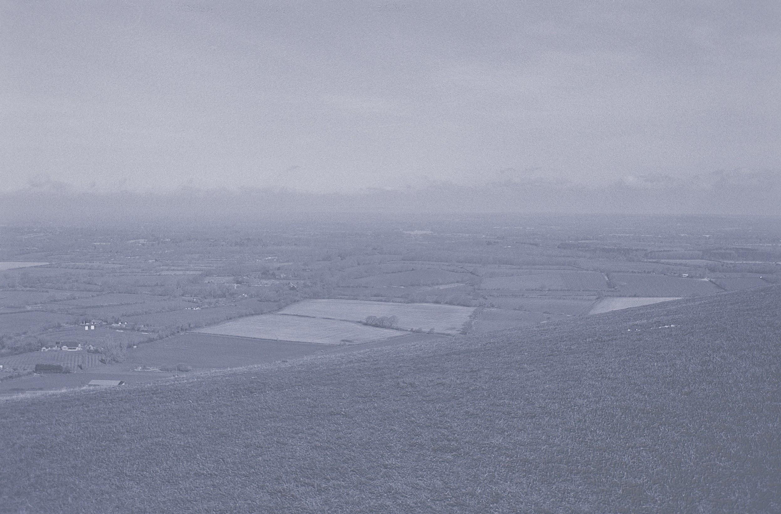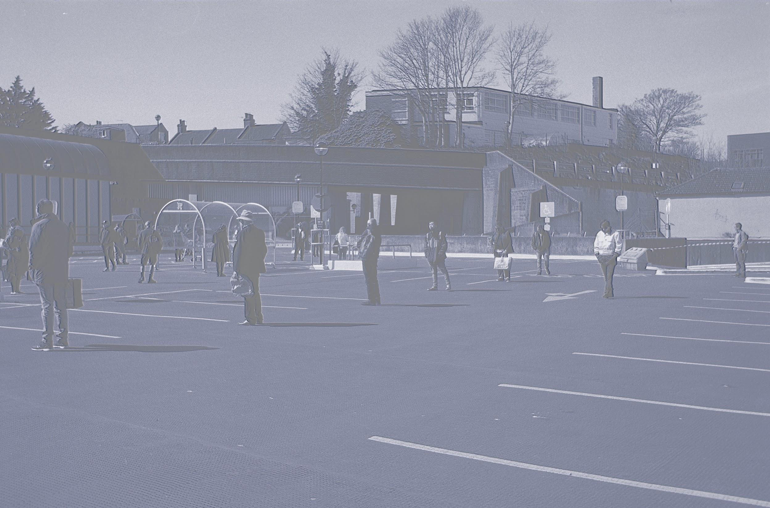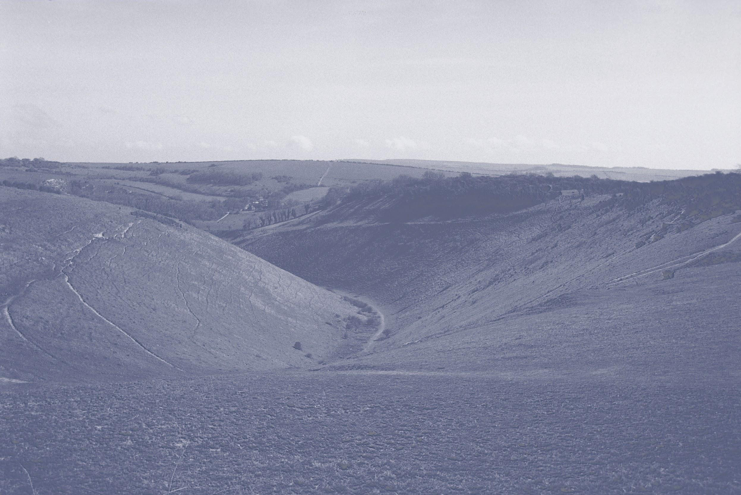The Landscape of Unknown
April 5, 2020
—
Idil Bozkurt
I closed my eyes and saw the vision field.
I listened to my breath. again and again,
nothing but this very moment.
I was here.
Now, I open my eyes and see my vision field.
Light and Shadow,
almost seeing the particles in the air.
here I go again.

İdil Bozkurt, The Landscape of an Unknown, 2020
“Disturbance realigns possibilities for transformative encounters.”
Anna Lowenhaupt Tsing, The Mushroom at the End of the World
I woke up this morning and remembered the dream I had, which, unlike others that slip away moments after waking, came back to me suddenly:
I was walking around the city. There was no one outside but me. I ambled through the streets secretly enjoying the quietness. Empty streets, bare gardens and barren shops. While I was wandering in the streets of this ghost town, I suddenly spotted a huge billboard on the side of the building. There, I realized that the words on the sign gave a proclamation of good news:‘From the 20th of April, we will be elevating the recent restrictions about your social life. You will be able to go out and socialise as normal. We are working very hard on it. Everything will get back to normal.’
When I awoke, I had a strong sense of the emotion that was left with me after having read the sign within my dream. The initial feeling I had was disappointment, which was followed by a state of panic and anxiety. ‘Is that it? We haven’t changed anything yet!’, I thought to myself. And, here I am writing this piece with all those feelings in my mind vividly, distinctively. Is there something wrong with me that deep down I secretly wish this crisis to continue until it reaches its meaningful end?
Meaningful end?
What does ‘meaningful end’ even mean? What do I expect this crisis to turn into? I wonder if I’m thinking like Winston Churchill who believes the rule- ‘never let a good crisis go to waste’? True or not, this expression is now commonly applied to economic or diplomatic crises that can be exploited to advance political agendas. To support this argument, frighteningly, there seems to be many recent examples of it- an opportunity for authoritarian power grabs in Hungary, Israel, China, the Philippines and the US, with more to follow undoubtedly.
This advice, of course, can be read as each crisis brings its own opportunity for a creative response. The matter of letting crises be wasted or not fills me with a sense of urgency. This urgency is followed by the fog of the unknown lingering in the air and it is hard to see what’s on the horizon, or even what’s in front of us. Although, staying put is hard especially while viewing digital totalitarian regimes rapidly take place, while healthcare professionals work in precarious conditions and society at large coping with social distancing during the COVID-19 outbreak. Millions of people have lost their jobs during this turbulence. In addition to this, I am also worried about the state of arts and culture, and especially art professionals who work independently with freelance or zero-hours contracts. For instance, in the city of Brighton, where I live, 40% of its revenue comes from festivals and cultural events across the year. The month of May is one of the best times to be in Brighton. There are four different festivals that are run throughout May. Of course, with the recent events, many of them are cancelled or postponed. Some festivals fund themselves through their ticket sales, and the cancellation of these festivals are not only affecting their ability for future participation, but also hitting the staff who intended to work with them. I count myself as one of those affected. I had two exhibitions cancelled along with many months of freelance jobs. I have not only realised the precariousness of my working conditions but I have found that I have started to reconsider the value of these works—what is the value of an exhibition? What does it mean to ‘go-online’ and continue producing content on digital platforms? What does it feel like to be in a virtual gallery? How does it affect our relationship with space, art and spectatorship? What is the role of the curator, here and now? How should we value public spaces now that we can no longer access them? How is this uncertain time going to affect artists?
Galleries and museums may well be the last places to be reopened to the public—then, will things go back to normal?
It’s important to see the reaction of many galleries and museums during the COVID-19 crisis. As many of us whose independent projects and works were cancelled, we joined with the rest of our friends and families at home, who are not only locked down in their households, but also locked to their screens. Right after the lockdowns a number of museums, art organisations and galleries responded to this moment of crisis by ‘going-online’ where they have continued to produce and disseminate their content through platforms such as Zoom, Instagram, Jitsi and many others with which they can broadcast talks,
live chats, workshops, virtual gallery tours and even virtual studio visits. They are still striving to keep us connected. We are quite grateful for this wide range of content being put in front of us while others are struggling to stay connected 24/7 and have started to suffer from digital ‘burn out’. Relevantly, for the last couple of years, there has been a rising debate on ‘burn out culture’, especially amongst freelance gig workers. I regularly hear from many colleagues and friends who are in a constant battle with this experience and struggle with burnout. As the majority of people all experience this endless exhaustion where work becomes an identity, capitalism becomes a religion and productivity manifests the way we measure human value. Here we are again, while everything has paused, we are still experiencing the digital side of burnout. I wonder what would happen if the whole art world stopped and went silent for a bit. If there were no arts content, what would it look like? If this is not a great time to slow down and reflect on the values of spaces that are dedicated to exhibiting art and the importance of our relationship with it, then when is it going to be?

The Landscape of an Unknown, 2020
Let me explain myself here. My intention is neither to throw a stone at the art institutions, museums or galleries nor do I desire to see the arts and creative sector crumbling down. They are not the essence of the problem but they are the part of the globalised production systems. For instance, contemporary biennials are a way of signalling a city’s headway to enter the globalizing world of trade and culture through the use of art to encourage tourism, cultural ‘growth’ and international media. Hito Steyerl puts this very clearly in her essay Duty Free Art where she says, “…contemporary art is made possible by neoliberal capital plus the internet, biennials, art fairs, parallel pop-up histories, growing income inequality. Let’s add asymmetric warfare -… real estate speculation, tax evasion, money laundering and deregulated financial markets to this list.” I’m not talking about the creation of arts but rather the roles of museums and art institutions in the context of the globalised system of production. The consequences of the globalised production systems in contemporary arts can be seen today in the growth of a certain form of art that is now supposed to be seen everywhere at biennials, also in a marked decrease in the ‘specificity’ of regional cultural output. We are facing the increasingly blurred and confused role of art in contemporary culture. In the last few years, the ideas of transformative change, placemaking, the role of artists and audience, funding and diversity have been the subjects that are widely discussed in art institutions, in public art spaces and galleries.
It seems to me that we all go around these subject matters, making mind maps, discussing and sharing stories but not feeling brave enough to delve into the essential questions about what the problem is with the state of art institutions in the contemporary art scene. How can we think of art institutions in an age of globalised production, growing inequality, climate emergency and digital technology? It’s important to rethink and reimagine many subjects like sustainability, diversity, equality and legacy here. Perhaps the answer lies not only in the act of looking to the past, but also in the construction of new conversations about public spaces, the formation of collective culture, and the future of art. Referring to Bruno Latour’s questions here, what are some suspended activities that you would like not to see coming back as an arts professional and/or an artist?
It might be useful to visit the concept of curare here. To take care of. Curators are assigned to the job of caring in the art world. Over the years, various forms of caretaking have evolved from this root word, but contemporary curator’s work remains similar to the curare of growing, developing and seeking to help the art of people, their meaning, interpretation and commonalities flourish. Now, the desk of many curators is empty – at least for the time being. Creating art is not always a question of the moment, and neither is its exhibition; curating follows art. So where do we start the conversation now? What sort of time and space is required for the manifestation of contemporary art?

The Landscape of an Unknown, 2020
“This machine is a master at collecting goods and people from around the world. It has the characteristics of an assemblage, yet it also has characteristics of a machine, a mechanism that is limited to the sum of its parts. This machine is not a total institution” as Anna Lowenhaupt Tsing puts it, we live and spend our lives inside of it. In my mind, I’m imagining the red button and the nice steel handle mentioned by Bruno Latour, and how the states, one after the other, can pull it to stop the engine. Here we are. Now.The engine has stopped, along with the noise it produced; the machine is not working -for now. We can start to hear things, other things that we could not hear or did not pay attention to before. As we all feel the somnolence that comes through adapting to our new routines, we should not lose the impetus for action. I have been thinking about my answers to questions posed by Bruno Latour*, below. Perhaps, now, we can all think and share some thoughts. So let’s not waste this crisis, instead think and ask ourselves some questions.
—
*Here are the questions posed by Bruno Latour in his article called What protective measures can you think of so we don’t go back to the pre-crisis production model? (translated from French by Stephen Muecke)
(This article appeared in AOC on 29th March 2020: https://aoc.media/opinion/2020/03/29/imaginerles-gestes-barrieres-contre-le-retour-a-la-production-davant-crise/)
Question 1: What are some suspended activities that you would like to see not coming back ?
Question 2: Describe why this activity seems to you to be noxious/superfluous/dangerous/incoherent and how its disappearance/putting on hold/substitution might render other activities that you prefer easier/more coherent. (Write a separate paragraph for each of the activities listed under 1).
Question 3: What kinds of measures do you advocate so that workers/employees/agents/entrepreneurs, who can no longer continue in the activities that you have eliminated, are able to facilitate the transition to other activities ?
Question 4: What are the activities, now suspended, that you hope might develop/begin again, or even be created from scratch ?
Question 5: Describe how this activity appears to be positive to you, and how it makes other activities easier/more harmonious/coherent that you prefer and can fight against those that you judge to be inappropriate. (Write a separate paragraph for each of the activities listed under 4).
Question 6: What kinds of measures do you advocate to help workers/employees/agents/entrepreneurs to acquire capacities/means/finances/instruments allowing for restarting/development/creation of this activity ? (Now find a way to compare your description with that of other participants. By tabling and then superimposing the answers, you should start to build up a picture composed of conflicting lines, alliances, controversies and oppositions.)
Idil Bozkurt (1990) is a lens-based media producer and an independent curator.
